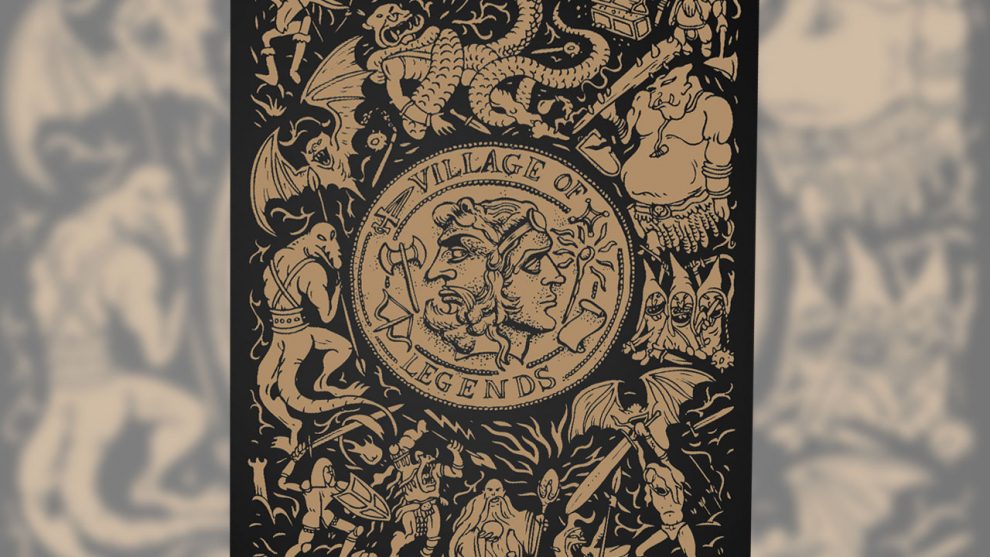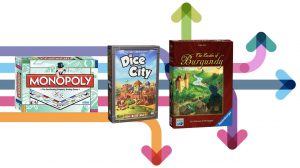Disclaimer: Meeple Mountain was provided a preview, prototype copy of the game. It is this copy of the game that this review is based upon. As such, this review is not necessarily representative of the final product. All photographs, components, and rules described herein are subject to change.
Overview
If you’ve ever played Dominion or Ascension or any one of the other myriad deckbuilding games then you should be well acquainted with what a deckbuilder is. For those uninitiated few, your typical deckbuilding game will start you out with a small deck of cards – some used to fight things and some used to buy things. In between the players, there will usually be a common supply of cards available for purchase or capture. These purchased/captured cards are usually more powerful than the basic cards that every player begins with and they are added to the player’s deck when they are acquired. As the players add cards and cycle through their decks over and over again, the players begin to become more powerful and their turns become much more interesting. This is the nature of all deckbuilders.
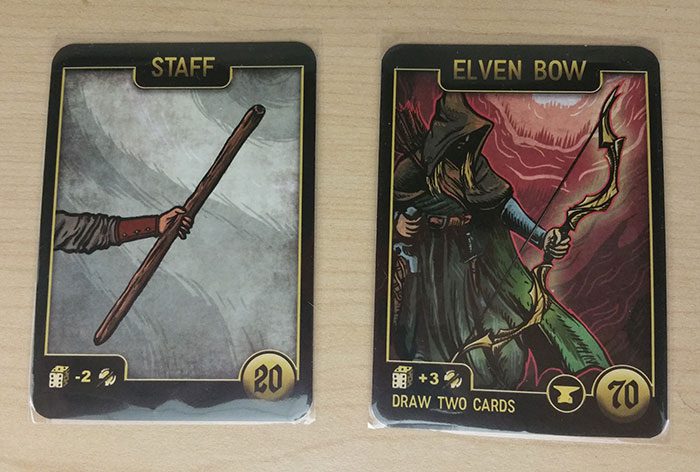
Village of Legends, designed by Lorenzo Lupi, is a deckbuilding game that takes place in a fantasy RPG setting. Like most deckbuilders, there is a central supply of cards that the players can choose from. These cards can be purchased by the players and added to their decks to help them become more powerful and more efficient in future turns. But, it’s in the differences that Village of Legends sets itself apart from other games of this type. Village of Legends gives each player a character sheet. As the players defeat monsters during the course of the game, their characters level up and become more powerful, thereby unlocking special skills and abilities. The players are also battling each other and, in the end, the last player standing will win the game.
Contents
Village of Legends comes with a Market board, 5 Character sheets (Mage, Elf, Barbarian, Dwarf, and Paladin), 10 markers that look like tiny paper clips, 2 dice, a rulebook, and a whole bunch of cards. These cards are roughly divided into three types – Starter cards, Standard Market cards, and Other Market cards. The Starter cards consist of Money and Staffs. The Standard Market cards are comprised of Beer, Scrolls, Spells, Healing Potions, and Nuggets. The Other Market cards are all of the various weapons, monsters, and effects that make up the rest of the game. I’ll talk a little more about these different card types later.
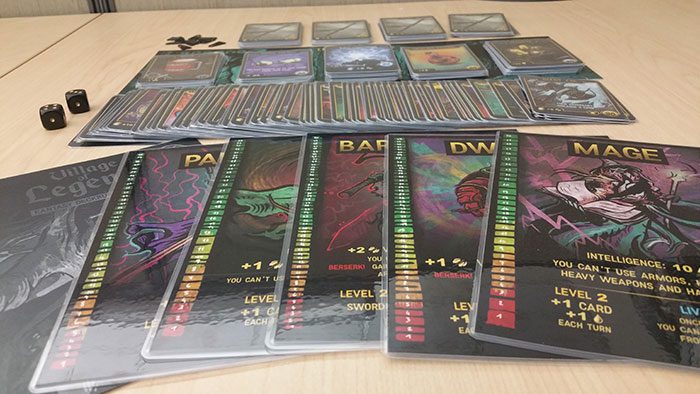
Each card has several similarities. First, the back of each card is illustrated with the Village of Legends logo. On the front of each card is the card’s title, an illustration of the card, and an area of text that describes what the card does (not all cards have this). In the bottom left hand corner of the card will be some iconography that describes the benefits the card provides or the cost associated with playing the card from your hand. In the bottom right of the card is the card’s cost which determines how much money must be spent to purchase the card from the market.
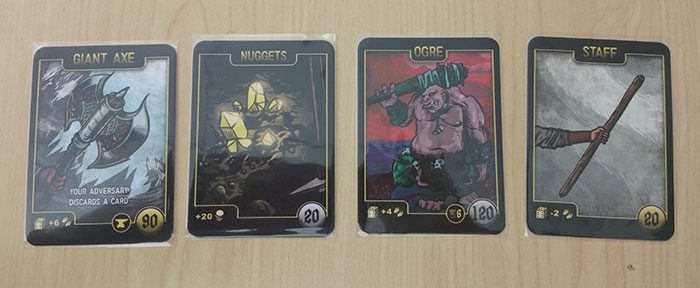
While I can’t really speak as to the quality of the final product, I can comment on the artwork and I’ll say this: WOW. I mean, seriously… wow! The artwork in this game is stellar. Not only did he design the game, but Lorenzo Lupi also illustrated it as well and I am duly impressed. If Mr. Lupi isn’t an illustrator professionally, then he is missing his calling. This is some of the best artwork that I have ever seen in a game.
Another thing worth noting here is that, even though this is just a prototype, Lorenzo Lupi went to the extra effort of sleeving all of the cards that were sent to me. He even hand printed the artwork onto the box that the game was packaged in. While this is not reflective of the final product, the box looks pretty cool and I’d like to show it to you here. Also, I think that the effort that he went into to put the best face on his prototype that he could is commendable and it shows a level of respect not only for his product, but for the people that are going to be reviewing it as well.
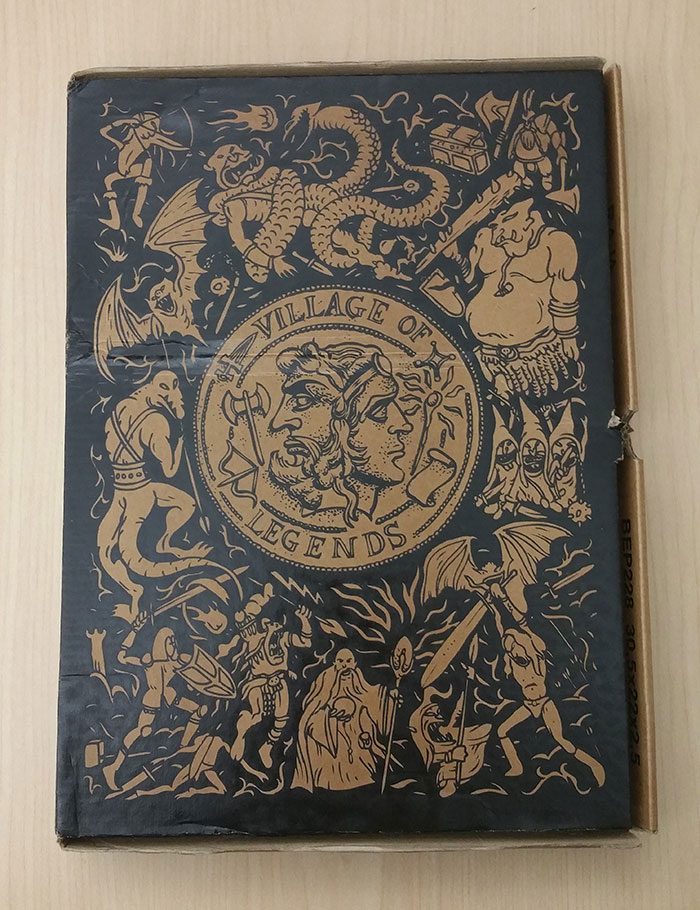
If reading about the game play bores you, then feel free to scroll down to the THOUGHTS section. For the rest of you, though…
Setup
The Market board is laid out and the Standard Market cards are divided into different decks by type. These decks are shuffled and placed face down into their appropriate spots on the Market board and the top card of each deck is flipped to its opposite side. Then each player receives their Starter cards (2 Staffs and 8 Coins). Any unused Starter cards are removed from the game. Then the remaining Other Market cards are shuffled into a deck which is placed next to the Market board, and five cards are drawn from the deck and placed face up beneath the cards that are already in the market.
Next, each player selects a character sheet (or is assigned one at random) and that player will place 1 marker on the left side of their character sheet at maximum health and another on the right side of their character sheet at 0 experience points. The players will then shuffle their Starter cards together and place them face down in front of them to form a deck. A starting player is selected and you are ready to begin.
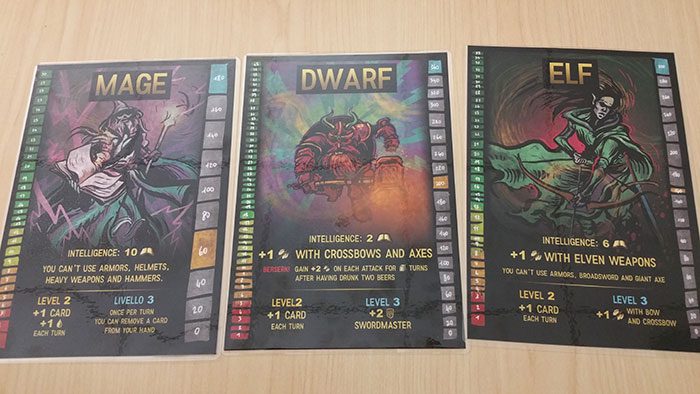
The Cards
Let’s talk some more about the different card types. As I mentioned already, there are five different types of Standard Market cards. Here’s what they are used for:
Beer: heals 1 hit point when played from the player’s hand while lowering their intelligence stat by 1. Beer can be used as a quick way of healing some damage, but is primarily used in conjunction with the Berserker ability which provides a player with an attack bonus for a number of rounds at the cost of denying them access to the market while they’re berserk.
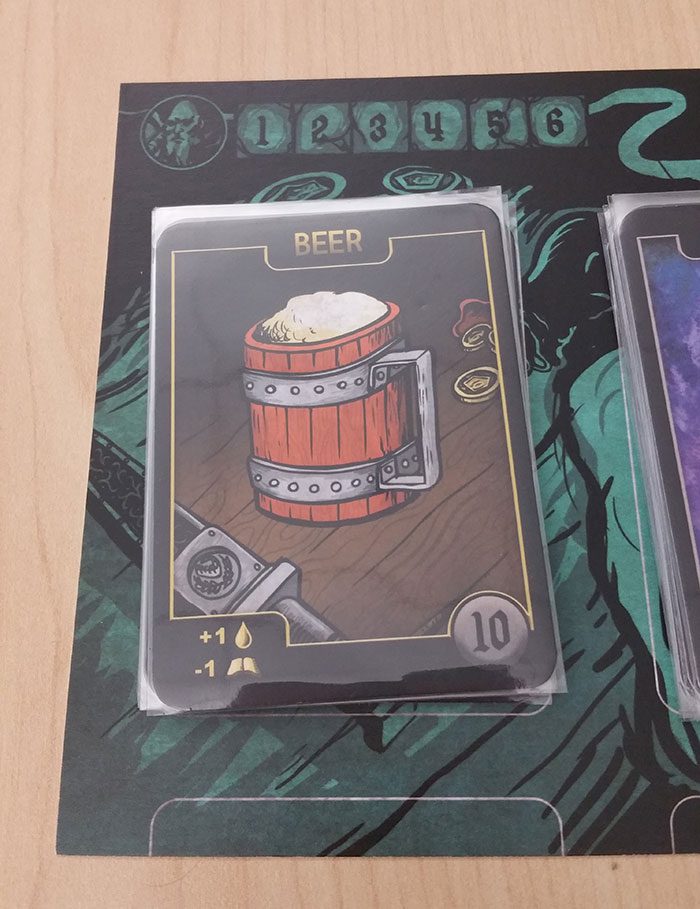
Scrolls: these have a variety of different functions and anybody can use them. For example, some provide temporary intelligence boosts while others allow the players to cycle through their cards at a faster rate.
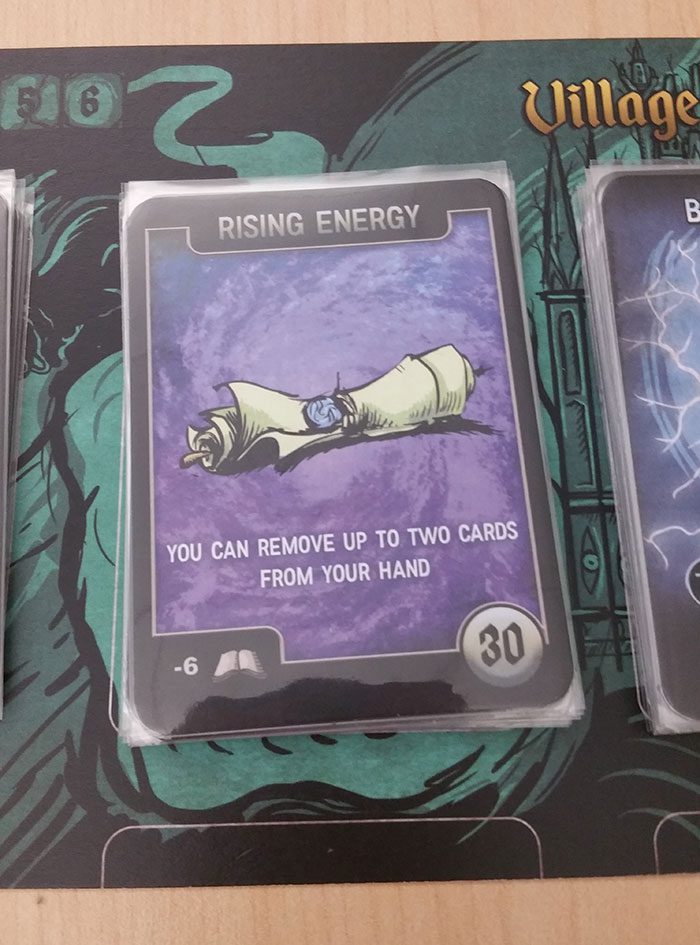
Spells: these cards provide powerful effects. Some are helpful to the caster and others are harmful to other players. For instance, the Fireball is a damage dealing spell while Gaea’s Gift gives the player a method of healing themselves. Each of these requires a certain amount of intelligence to use and this cost is deducted from their available intelligence pool when it is paid.
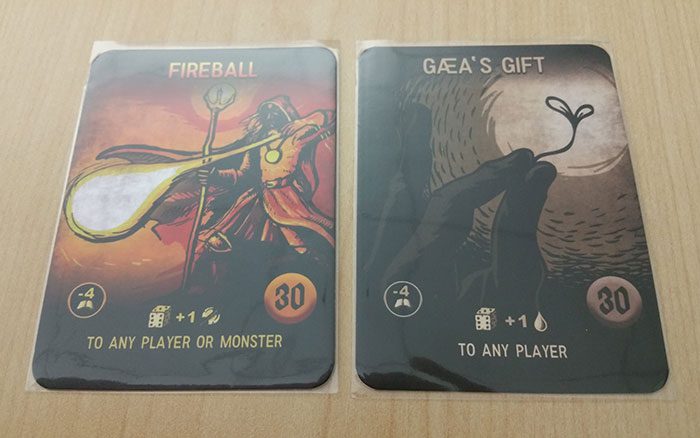
Potions: these are used for healing. When a player plays one of these, then they will recover an amount of hitpoints determined by the text on the card.
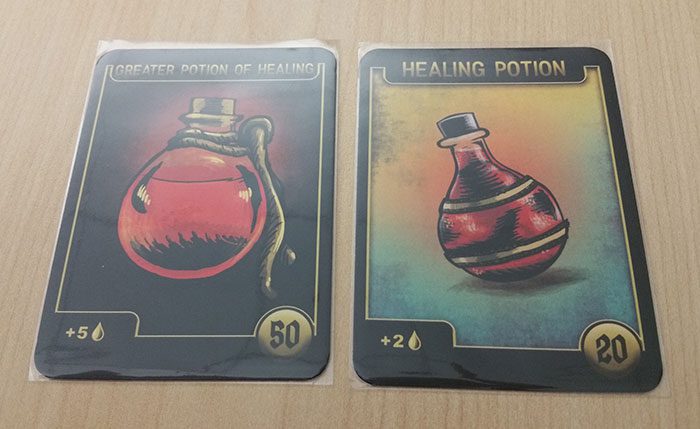
Nuggets: these provide 20 gold when they are put into play whereas the Starter card Coins only provide 10 apiece.
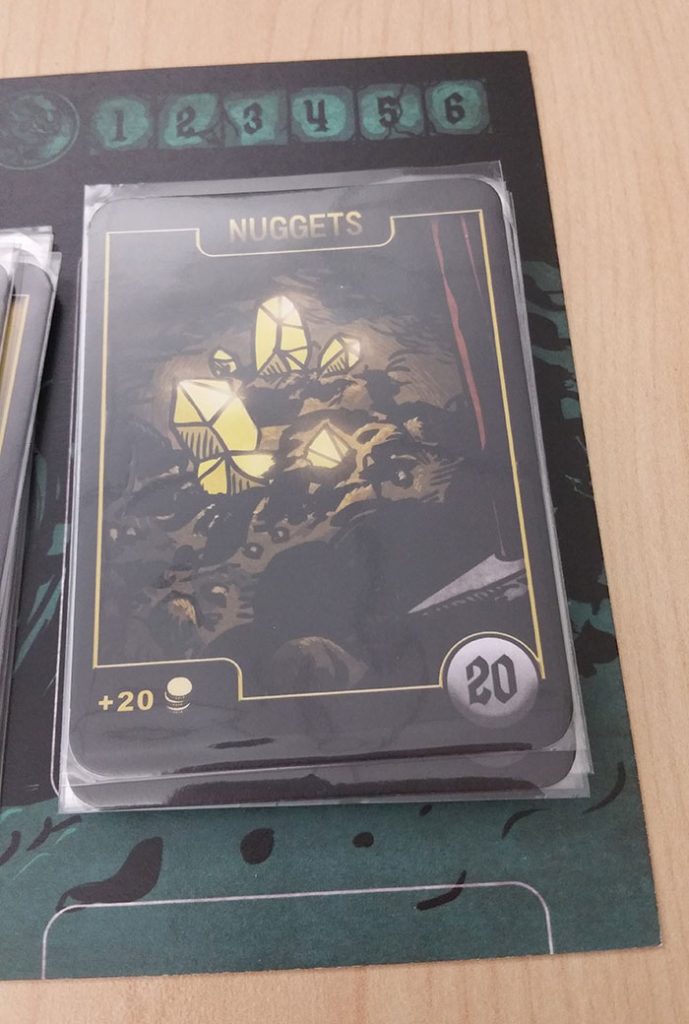
The Other Market cards are divided into several types – Weapons, Heavy Weapons, Defenses, Chests, and Monsters. Here’s how these are handled:
Weapons and Heavy Weapons: these are used to either deal damage to monsters or other players. There are specific rules of whom a player may attack and when, but I won’t go into a lot of detail about that. There’s a downloadable rulebook from the Kickstarter page if you’re interested in those. Each weapon does an amount of damage that is determined by rolling the dice and then adding or subtracting a value from the total.
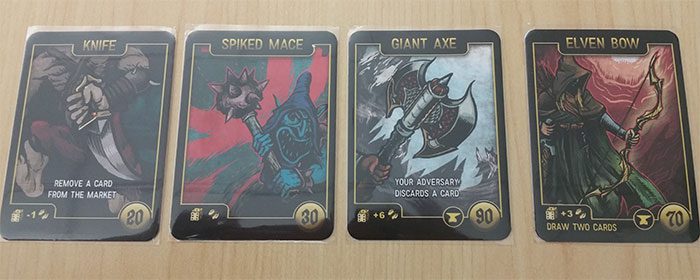
With the exception of heavy weapons, any number of weapons may be used during a player’s turn. If a heavy weapon is used, then no other weapons may be used. After overcoming a Defense card or a Monster card, heavy weapon damage will spill over and damage the opponent that is being attacked or controls the monster that is being attacked. The damage from normal weapons does not spill over in this way.
Defenses: these cards sit in front of the player that controls them and provide a damage buffer that their opponents or monsters must get through in order to damage the player that controls the Defense card.
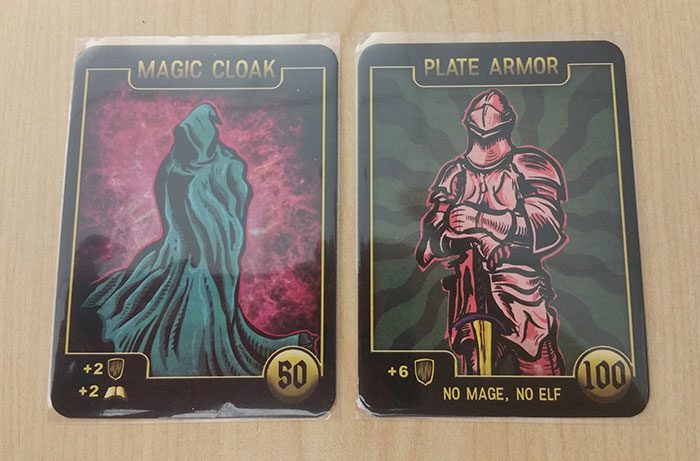
Chests: these cards provide the player that is using them with a variable amount of money during the turn. This amount is determined by a die roll.
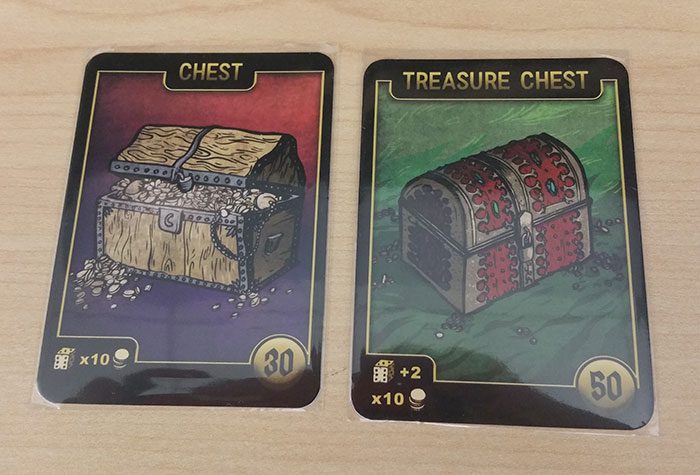
Monsters: these cards are deployed in front of opponents. While one of your opponents has a Monster card in front of them, they will be unable to interact with the market until the monster is eliminated. Additionally, as long as that Monster card is there, it will attack the player at the beginning of their turn. At the bottom of each Monster card is the monster’s hit points. Whenever a Monster card is defeated, the player receives experience points equal to the Monster card’s market value.
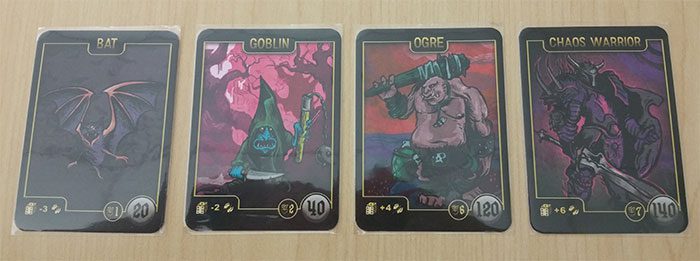
Anatomy of a Turn
At the beginning of a player’s turn, they will have five cards in their hand. Before anything else can be done, the player must check for monsters. If there are any Monster cards placed in front of the active players, then the Monster cards will attack the player. Whenever a player is attacked by a Monster or a normal weapon, then the attack must overcome any Defense cards the player has placed in front of them in order for the attack to do any damage to the player. If the player is unable to defeat the Monster card, then they will not be able to interact with the market on that turn, so any cards that provide any type of income would be useless. However, they can still use other cards such a Healing Potions.

If the player is able to defeat the Monster card (assuming there is one), they will gain the experience points for doing so, and the Monster card is returned to its controller’s discard pile. Then the active player can play out their turn as normal – shopping, healing, attacking, casting spells, or deploying monsters. If a player decides to attack another player, then they can only attack the player on their left. If the player decides to go shopping, then any cards purchased from the market are added to the player’s discard pile. When the player is unable to do anything else, then all of the cards they used that turn, along with any left unused in their hand, are added to the player’s discard pile and five new cards are drawn. Then play passes clockwise to the next player in turn.
End Game
Play continues until every player except for one has been defeated. The last player remaining is the victor.
Thoughts
Village of Legends has a lot of good things going for it and very few negatives. First, I’ve mentioned it before and I’ll say it again, the artwork in this game is amazing! I mean, just look at all of the pictures above and you can clearly see that for yourself. From a purely visual standpoint, this game has got it going on!
Second, each of the different classes in this game features their own variable player powers. This is very useful for guiding you in strategizing which cards to obtain from the market and which ones to leave alone, what skills you should be focusing on, and how you might want to develop your deck overall. For instance, the Mage has very high intelligence, but very few hit points, so this player will probably want to focus heavily on obtaining spells and healing potions. The Paladin gets a bonus for using swords, so they will most likely be trying to obtain those. A clever player can also use this public knowledge as a guide for removing cards from the market that might be useful for other players. Variable player powers in any game are typically really good things to have as they help to keep the game fresh and exciting from one play to the next. This holds true in Village of Legends as well.
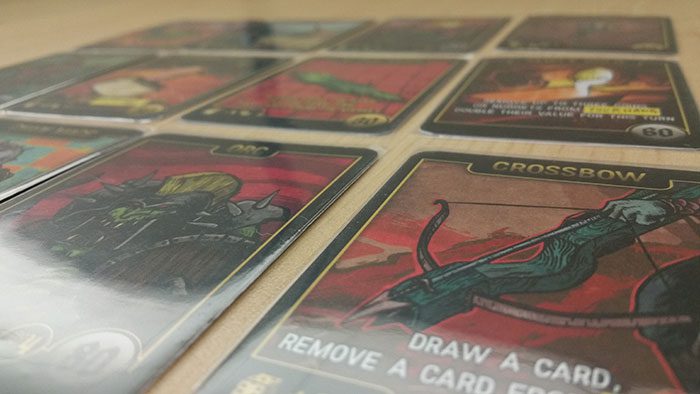
I also enjoy the leveling aspect of the game. I found myself hoping and praying that someone would drop a Monster card on me so that I could hopefully get a few more experience points to unlock the next ability on my character sheet. Being able to heal a free hitpoint or draw an extra card on each turn is an invaluable ability to have at your disposal, and having a goal to work towards is always a useful thing to have in any game.
Another thing that I really enjoy in this game is that there are multiple methods of “deck thinning”. At any time on your turn, you can sell as many cards from your hand as you like (the terms “sell” and “remove” mean to remove the card from the game) to gain half of their market value as income for the turn. This gives you a handy way of getting rid of cards that might not be useful to you anymore so that you can more quickly get to the ones that are helpful. In any deckbuilder, having an ability that can help you thin your deck is an incredibly useful thing to have access to. Village of Legends gives everybody this ability right off the bat and I heartily approve of this decision.
However, not everything about the game is perfect. For one thing, this game is completely built around a player elimination mechanic and that might not sit well with a lot of people. The mechanic is held in check somewhat by the limitation of only being able to attack the person to the left of you. However, if you’re unfortunate enough to be eliminated early on, you could be waiting awhile for a victor to emerge – especially at higher player counts.
This brings me to another downside. Even though I really enjoy myself when I play this game, this isn’t necessarily true for everyone else at the table, and this is because this game can be rather long. At some point, if you’re playing against a player that has invested heavily in healing potions and spells, this becomes a game of attrition. You whittle away their health. They restore it. Rinse and repeat ad infinitum until someone eventually manages to land a few lucky blows and bring the game to an end. Albeit, this is precisely the point of investing heavily in healing and defenses, but still, it can take awhile. So, be forewarned.
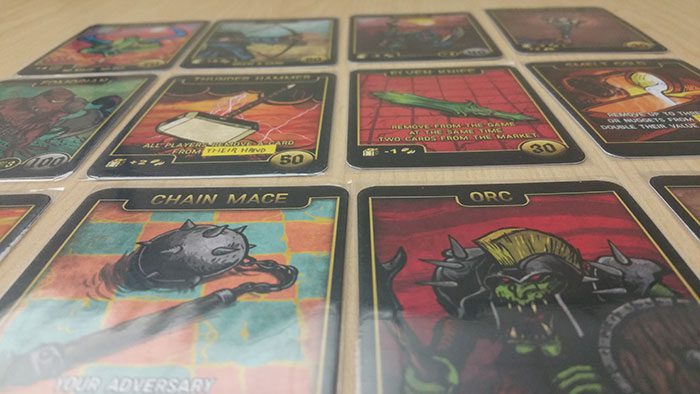
My last gripe is a relatively small thing that doesn’t really affect the gameplay very much. Still, it bothers me a bit so I feel like I should be honest about it. It’s actually a two-parter. The rules state that damage to Monster cards will carry over from one round to the next if the damage done was insufficient to eliminate the Monster card. There is a single tracker at the top of the market card which is supposed to be used to track this Monster card health, but this is never mentioned in the rule book. Aside from this one single tracker, there is no method provided in the box to keep track of a Monster card’s health. That being said, the campaign’s very first stretch goal is tailored to address this very thing. If the campaign succeeds and the goal gets unlocked, then this will become a non-issue.
The second part of this is that there is also no method in place for tracking who controls a specific Monster card. Typically, this isn’t going to be much of an issue since you’re only allowed to attack the person on your left. However, there is a 4-player team variant. In this variant, each person on a team sits across from the teammate. It is entirely possible that one of these team members could be eliminated forcing the remaining teammate to face down both opponents at the same time. In this rare instance, it is conceivable that there could be multiple monsters played against that player and there would be no method for distinguishing which Monster card belonged to which player without some agreed upon method of placing the cards on the table. It would be much simpler to have a control marker of some sort that could be placed on top of the Monster cards.
Overall, though, I really enjoyed Village of Legends. It’s a very solid deckbuilder with some clever and unique ideas. It’s very well designed and the classes are evenly balanced. The variable player powers provide the game with a decent level of replayability and the rules are clearly written and easy to understand. Also, in case you missed it earlier, the artwork in the game is phenomenal. I cannot stress that enough. If you like what you’ve read here and wind up backing this game, you won’t be disappointed.


